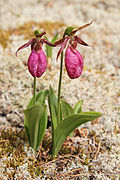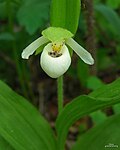Cypripedium is a genus of 58 species and nothospecies of hardy orchids; it is one of five genera that together compose the subfamily of lady's slipper orchids (Cypripedioideae). They are widespread across much of the Northern Hemisphere, including most of Europe and Africa (Algeria[2]) (one species), Russia, China, Central Asia, Canada the United States, Mexico, and Central America.[1][3][4][5] They are most commonly known as slipper orchids, lady's slipper orchids, or ladyslippers; other common names include moccasin flower, camel's foot, squirrel foot, steeple cap, Venus' shoes, and whippoorwill shoe. An abbreviation used in trade journals is "Cyp." The genus name is derived from Ancient Greek Κύπρις (Kúpris), an early reference in Greek myth to Aphrodite, and πέδιλον (pédilon), meaning "sandal".[6]
| Cypripedium | |
|---|---|
 | |
| Showy lady's slipper (Cypripedium reginae) | |
| Scientific classification | |
| Kingdom: | Plantae |
| Clade: | Tracheophytes |
| Clade: | Angiosperms |
| Clade: | Monocots |
| Order: | Asparagales |
| Family: | Orchidaceae |
| Subfamily: | Cypripedioideae |
| Genus: | Cypripedium L., 1753 |
| Type species | |
| Cypripedium calceolus L., 1753 | |
| Synonyms[1] | |

Most of Cypripedium grow in temperate and subtropical climates, but some species grow in the tundra in Alaska and Siberia, which is an unusually cold habitat for orchids. Other species occur well into tropical areas such as Honduras and Myanmar.[1]
Some of the northern species can withstand extreme cold, growing under the snow and blooming when the snow melts. But, in the wild, some have become rare and close to extinction, due to an ever shrinking natural habitat and over-collection, people prizing the flowers for their beauty. Several species are legally protected in some regions. In the late 20th century, only a single known plant of Cypripedium calceolus survived in Britain.
Characteristics edit
The Cypripedium are terrestrial and, as with most terrestrial orchids, the rhizome is short and robust, growing in the uppermost soil layer. The rhizome grows annually with a growth bud at one end and dies off at the other end. The stem grows from the bud at the tip of the rhizome. Most slipper orchids have an elongate erect stem, with leaves growing along its length. But the mocassin flower or pink lady's slipper (Cypripedium acaule) has a short underground stem with leaves springing from the soil. The often hairy leaves can vary from ovate to elliptic or lanceolate, folded (plicate) along their length. The stems lack pseudobulbs.
The inflorescence is racemose. It can carry one to twelve flowers, as in Cypripedium californicum. But most species have one to three flowers. There are three sepals, with, in most species, the two lateral ones more or less fused. The flower has three acute petals with the third a striking slipper-shaped lip, which is lowermost. The sepals and the petals are usually similarly colored, with the lip in a different color. But variations on this theme occur. The aspect of the lip of different species can vary a great deal. As with all orchids, it is specially constructed to attract pollinators, which it traps temporarily. The flowers show a column with a unique shield-like staminode. The ovary is 3-locular (with three chambers).
Taxonomy edit
Comparison between a DNA-analysis and the morphological characteristics in this genus has shown that there is a high degree of divergence between the two, probably due to long periods of isolation or extinction of intermediate forms. The Eurasian species with yellow or red flowers form a distinct group from the North American species with yellow flowers. The Mexican Pelican Orchid (Cypripedium irapeanum) and the California lady's slipper (Cypripedium californicum) are probably the first diverging line. They share several similarities with their sister group Selenipedium.
Species and natural hybrids edit
There are 58 currently recognized species and nothospecies (naturally occurring hybrids) recognized in this genus, as of May 2014:[1]
Subgenus Cypripedium edit
| Section | Image | Name | Distribution |
|---|---|---|---|
| Acaulia |  | Cypripedium acaule – Mocassin flower, Pink lady's slipper, Two-leaved lady's slipper | C. and E. Canada, NC & E USA |
| Arietinum |  | Cypripedium arietinum – Ram's-head lady's slipper | C & E Canada, NC & NE USA |
 | Cypripedium plectrochilum | N Myanmar to SC China | |
| Bifolia |  | Cypripedium guttatum – Spotted lady's slipper | European Russia to Korea, Alaska to Yukon |
 | Cypripedium yatabeanum | Russian Far East to N & NC Japan, Aleutian Islands to SW Alaska | |
| Cypripedium |  | Cypripedium calceolus – Yellow lady's slipper | Europe to Japan |
 | Cypripedium candidum – Small white lady slipper | SE Canada, NC & E USA | |
 | Cypripedium cordigerum – Heart-Lip lady's slipper | N Pakistan to Himalaya, S Tibet | |
| Cypripedium farreri | China | ||
| Cypripedium fasciolatum | China | ||
 | Cypripedium henryi – Henry's lady's slipper | C China | |
 | Cypripedium kentuckiense – Kentucky lady's slipper, Southern lady's slipper | C & E USA | |
 | Cypripedium montanum – Large lady's slipper, Mountain lady's slipper, White lady's slipper, Moccasin flower | Alaska to California | |
 | Cypripedium parviflorum Salisb. – (Greater) yellow lady's slipper, moccasin flower, or hairy yellow ladyslipper | Canada, E USA | |
| Cypripedium segawai | EC Taiwan | ||
 | Cypripedium shanxiense | China to N Japan | |
| Eniantopedilum |  | Cypripedium fasciculatum – Brownie lady's slipper, Clustered lady's slipper | W USA |
| Flabellinervia |  | Cypripedium japonicum – Japan lady's slipper | China, Korea, Japan |
| Cypripedium formosanum – Formosa lady's slipper | C Taiwan | ||
| Macrantha | Cypripedium calcicolum | China | |
 | Cypripedium franchetii – Franchet's lady's slipper | C & SC China | |
| Cypripedium himalaicum | SE Tibet to Himalaya | ||
| Cypripedium ludlowii | SE Tibet | ||
 | Cypripedium macranthos – Large-flowered lady's slipper | E Belarus to temperate E Asia | |
| Cypripedium taibaiense | China | ||
 | Cypripedium tibeticum | Sikkim to C China | |
| Cypripedium yunnanense | SE Tibet, China | ||
| Retinervia |  | Cypripedium elegans | E Nepal to China |
 | Cypripedium debile – Frail lady's slipper | Japan, Taiwan, China | |
| Cypripedium palangshanense | China | ||
| Sinopedilum | Cypripedium bardolphianum | China | |
| Cypripedium forrestii | China | ||
| Cypripedium micranthum | China | ||
| Trigonopedia | Cypripedium daweishanense (S.C.Chen & Z.J.Liu) S.C.Chen & Z.J.Liu (2005) | Yunnan, China South-Central | |
 | Cypripedium fargesii | China | |
| Cypripedium lentiginosum | China | ||
 | Cypripedium lichiangense S.C.Chen & P.J.Cribb | China (SW Sichuan, NW Yunnan), NE Myanmar | |
| Cypripedium malipoense S.C.Chen & Z.J.Liu | Yunnan, China South-Central | ||
| Cypripedium margaritaceum – Pearl-white lady's slipper | China | ||
| Cypripedium sichuanense | China | ||
| Cypripedium wumengense | China |
Subgenus Irapeana edit
| Section | Image | Name | Distribution |
|---|---|---|---|
| Irapeana |  | Cypripedium californicum – California lady's slipper | Oregon, N. California |
| Cypripedium molle | Mexico | ||
 | Cypripedium dickinsonianum | Mexico (S Chiapas) to Guatemala | |
 | Cypripedium irapeanum – Pelican Orchid, Irapeao lady's slipper | Mexico to Honduras | |
| Obtusipetala |  | Cypripedium flavum – Yellow lady's slipper | SE Tibet, SC China |
 | Cypripedium passerinum – Franklyn's lady's slipper, small white Northern lady's slipper, sparrow's egg lady's slipper | Alaska to Canada, Montana | |
 | Cypripedium reginae Walter – Large white lady's slipper, Queen's lady's slipper, showy lady's slipper | C & E Canada, E. USA | |
| Subtropica | Cypripedium subtropicum | SE. Tibet | |
| Cypripedium wardii | SE. Tibet, China |
Natural Hybrids edit
| Image | Scientific name | Common Name | Distribution |
|---|---|---|---|
| Cypripedium × alaskanum | C. guttatum × C. yatabeanum | Alaska | |
 | Cypripedium × andrewsii | C. candidum × C. parviflorum var. pubescens | E Canada, NC & NE USA |
| Cypripedium × catherinae | C. macranthon × C. shanxiense | Russian Far East | |
 | Cypripedium × columbianum | C. montanum × C. parviflorum var. pubescens | W Canada, NW USA |
| Cypripedium x herae | C.parviflorum x C.reginae | Manitoba, Canada | |
 | Cypripedium × ventricosum | C. calceolus × C. macranthos | Russia to Korea |
| Cypripedium × wenqingiae | C. farreri × C. tibeticum | China |
Uses edit
The genus has a long history of use, dating back 2,500 years to the Far East, where they were used medicinally.
Conservation edit
Several orchid species thought to be extinct in the United Kingdom including one native species in this genus have been found in habitat and are currently the subject of aggressive conservation efforts to protect and restore these showy plants to their native ranges.[7]
Awards edit
The following have received the Royal Horticultural Society's Award of Garden Merit:-
References edit
- Phillip Cribb & Peter Green (1997). The Genus Cypripedium (a botanical monograph). Kew Royal Botanic Gardens, Timber Press ISBN 0-88192-403-2
- Pridgeon, A.M.; Cribb, P.J.; Chase, M.W. & F. N. Rasmussen (1999): Genera Orchidacearum Vol.1, page: 114 ff., Oxford U. Press. ISBN 0-19-850513-2
- ^ a b c d "Cypripedium". World Checklist of Selected Plant Families (WCSP). Royal Botanic Gardens, Kew.
- ^ Walid, Nemer & Rebbas, Khellaf & Krouchi, Faiza. (2019). Découverte de Cypripedium calceolus (Orchidaceae) au Djurdjura (Algérie), nouvelle pour l’Afrique du Nord. Flora Mediterranea. 29. 207-214. 10.7320/FlMedit29.207.
- ^ "Cypripedium calceolus". Altervista Flora Italiana.
- ^ Chen, Xinqi; Cribb, Phillip J. "Cypripedium". Flora of China – via eFloras.org, Missouri Botanical Garden, St. Louis, MO & Harvard University Herbaria, Cambridge, MA.
- ^ Sheviak, Charles J. (2002). "Cypripedium". In Flora of North America Editorial Committee (ed.). Flora of North America North of Mexico (FNA). Vol. 26. New York and Oxford: Oxford University Press – via eFloras.org, Missouri Botanical Garden, St. Louis, MO & Harvard University Herbaria, Cambridge, MA.
- ^ "Meet The Ladies: The Slipper Orchids". USDA Forest Service. Retrieved 1 June 2015.
- ^ Jowit, Juliette (3 August 2010). "Ghost orchid comes back from extinction". The Guardian. Retrieved 1 June 2015.
- ^ "Cypripedium formosanum". RHS. Retrieved 5 May 2020.
- ^ "Cypripedium Hank Small gx". RHS. Retrieved 5 May 2020.
- ^ "Cypripedium Michael gx". RHS. Retrieved 5 May 2020.
- ^ "Cypripedium reginae". RHS. Retrieved 5 May 2020.
- ^ "Cypripedium Sabine gx". RHS. Retrieved 5 May 2020.
External links edit
 Media related to Cypripedium at Wikimedia Commons
Media related to Cypripedium at Wikimedia Commons Data related to Cypripedium at Wikispecies
Data related to Cypripedium at Wikispecies- Cypripedium - Infos by Mr. Frosch
- Photos of Chinese Slipper Orchids
- Cypripedium japonicum Cypripedium macranthum var. hotei-atsumorianum Images of Japanese Cypripedium
- Cypripedium picture database

